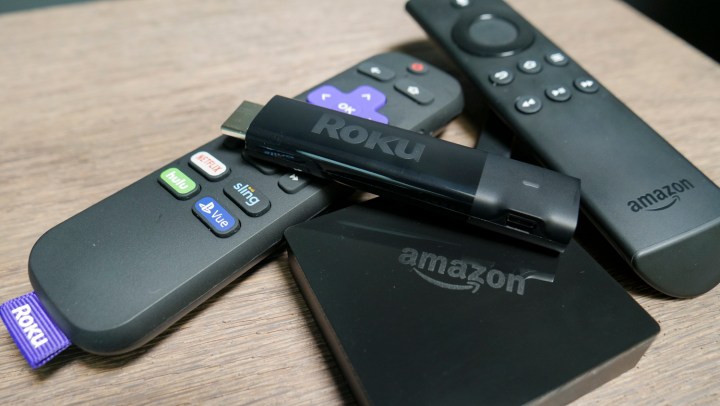When it comes to on-demand streaming video services, there are none bigger than Netflix. It’s far and away the most popular service of its kind both in the U.S. and internationally. But that doesn’t mean it’s the only option. As the market for these services matures, more competitors are emerging all the time. One of the most compelling for a lot of people is Amazon Prime Video, simply because so many people already have relationships with Amazon.
And yet, as much as these two services both compete for our entertainment dollars, they’re radically different from each other in several areas such as price, content selection, and extra features. So, if forced to choose just one, which one do you choose? It’s not necessarily an easy decision, so we’ve assembled a cheat sheet that lets you compare the two on some of the most important criteria. So get your scorecard and your wallet ready … it’s Netflix vs. Amazon Prime. Let’s get ready to rumble.
Price

We’ll kick it off with one of the biggest differences: How much you’ll have to pay if you want to watch. Netflix’s pricing model is very easy to understand: There are three tiers of video streaming service, called Basic ($9 per month), Standard ($14 per month), and Premium ($18 per month).
Each Netflix subscription gives you access to Netflix’s entire catalog of ad-free movies, TV shows, and specials. The only things that change as you pay more are the quality of the video and the number of devices that can be used to stream simultaneously. Basic, as the name implies, gives you a single stream and limits you to standard definition (480p). Standard gives you a second simultaneous stream, and both are available in HD (up to 1080p). Premium lets four devices watch at the same time, and content can be streamed in up to 4K Ultra HD with HDR, as well as Dolby Atmos (when the show or movie is available in these formats).
Amazon Prime Video is even more straightforward. A $119 annual Amazon Prime membership gives you ad-free access to the full Amazon Prime Video catalog, plus several shopping-related benefits that Amazon throws in for that price (and even Amazon’s music service). If you prefer, you can also get Amazon Prime for $13/month, or subscribe to only Amazon Prime Video for $9/month.
The Amazon Prime annual membership lets you stream in the highest quality that your TV, streaming device, and an internet connection can support, including 4K Ultra HD with HDR, as well as Dolby Atmos. As with Netflix, this will vary by movie or TV show. All Prime Video memberships let you stream up to three titles at the same time, but you only can stream the same title on two devices at a time.
Even Netflix’s most affordable price plan is about the same as Amazon Prime Video, which means that on a purely financial basis, Amazon Prime Video wins this round.
Winner: Amazon Prime Video
Device support

Having a streaming membership doesn’t make much sense if it isn’t compatible with the devices you own. Amazon Prime Video is compatible with a wide variety of devices and platforms, including web browsers on a PC or Mac, Roku, Apple TV, Amazon’s own Amazon Fire TV and Amazon Fire devices, iOS, Android, Xbox One and Series X, Xbox 360, PlayStation 3 and later, Nintendo Wii U, various models of connected Blu-ray players, smart TVs, and Google’s Chromecast.
Netflix, as the progenitor of the streaming media space, has the most device compatibility of any service. With support for all of the same devices as Amazon, as well as several others including Nintendo 3DS and Windows Phone, we’ll hand this one to Netflix. But now that Amazon and Google have buried the hatchet and Chromecast has been added to the list, it’s closer than ever.
Winner: Netflix
Content

Netflix has thousands of licensed Hollywood movies, TV shows, documentaries, and specials. But over the years, it’s Netflix’s original productions, like The Queen’s Gambit, Bridgerton, The Witcher, Stranger Things, and The Umbrella Academy, that have been stealing the spotlight and increasing Netflix’s desirability. The only content creator that consistently beats Netflix in quality is HBO — fans of shows like Succession, Game of Thrones, and Veep know exactly what we mean.
In fact, over the years, Netflix has been steadily reducing its catalog of movies as it increases its TV show arsenal, and its originals are a big part of that growth. Unfortunately, with the launch of the Disney+ streaming service, Netflix is slowly being stripped of some of its most popular movies. In the coming months, it’s expected that all new Marvel, Disney, and Star Wars franchise installments will become Disney+ (and/or Hulu) exclusives, and it’s unknown how long Disney will let Netflix continue to license existing titles, like the massively popular Avengers and Star Wars movies.
If you’re purely looking at Netflix as an alternative to renting Blu-rays or going to the theater, this might not sound like a good development. But, even stripped of these titles, it’s hard to beat Netflix’s offerings if you value high-quality entertainment from virtually every genre.
Amazon Prime Video has a much larger total library of movies and TV shows, according to recent reports — more than 24,000 movies and 2,100 shows, in fact — dwarfing both Netflix and Hulu. But size isn’t everything. Amazon’s most recognizable Hollywood films tend to be older, and among the good, there are plenty of mediocre titles (or worse). In addition to their recent acquisition of MGM, which means access to franchises including James Bond and Rocky, as well as shows like The Handmaid’s Tale, Amazon also has been making investments in its own original content, like The Marvelous Mrs. Maisel, Fleabag, Jack Ryan, and The Man in the High Castle. In the long term, this is probably the right strategy, but so far, Amazon just can’t compete in that arena.
Winner: Netflix
User experience, audio, and video

Amazon’s interface can be a bit unwieldy. It varies in style and usability from one device to another, with the best experience (no surprise) on its own Fire TV media streamers, while the execution on some smart TVs is less intuitive. The web interface for Prime Video is presented as a section within Amazon’s online store, rather than its own, stand-alone experience. This can be a bit jarring, especially when you’re trying to figure out how to search for a movie. The big search bar at the top of the screen is the right place, but it sure does look like you’re about to search Amazon.com, not Amazon Prime Video. While Amazon has added the ability for users to create up to six profiles, the service’s video recommendation engine isn’t especially sophisticated. Complaints that it can be hard to find something decent to watch are not uncommon.
One feature trivia lovers will appreciate is Amazon’s X-Ray. It lets you access cast photos, bios, filmographies, soundtrack info, and trivia, without leaving your playback screen.
Video quality is generally very good on Amazon Prime Video, and it’s remarkable that the service doesn’t charge more money for titles that are available to be streamed in up to 4K with HDR and Dolby Atmos. Wherever the content allows, soundtracks are offered in Dolby 5.1 surround. Still, some people have observed that Prime Video’s quality can vary, even with very fast internet connections, so your experience may vary.
Netflix, meanwhile, has one of the most consistent interfaces, with only slight changes from one device to another that are usually designed to embrace the strengths of a certain platform, like its mobile-optimized Netflix apps for Android and iOS. You can have multiple user profiles, each with its own unique recommendations, a kids-only profile to keep things perfectly PG-rated, and if you get tired of browsing the wide range of categorized content, an excellent search function is never far away. And the streamer finally gave users the option of disabling that annoying auto preview feature.
Video and audio quality on Netflix is superb. The company has mastered the art of adjusting its level of video compression to match your internet connection speed, so unless you intentionally set the video quality to a lower level to conserve data, you should get crystal-clear picture and sound — especially if you’re on the Premium plan. As with Amazon Prime, 5.1 Dolby surround is available for most movies and shows, unless Dolby Atmos is offered at a higher level (assuming your A/V gear supports it).
With top-quality audio and video, as well as a user interface that we love (despite the annoying previews), Netflix grabs this one, too.
Winner: Netflix
Live TV and extras

One of the appealing parts of Netflix is that it’s an all-in proposition: One monthly price gives you access to everything. But if you’re a cord-cutter, you may want something more as you try to fill the gap left by your now-canceled cable subscription.
It’s worth noting that Amazon Prime Video gives you access to two types of premium content not included in the $119 annual Prime membership. There’s a “Rent or Buy” section that provides a good selection of both newer movies and classics, at prices as low as $4. There’s also Amazon Channels, which is a way of subscribing to third-party cable networks like Showtime, Epix, Starz, and CBS All Access, to name a few. These channels often offer the option of watching shows live, as they would normally air over cable or satellite, plus you can access all of the content on-demand after the initial air date. The prices vary, but the à la carte arrangement can be attractive for those who simply want HBO in their lives and don’t want to create a new subscription in a separate app to do so.
Amazon Prime also gives you the perks of having access to some free content too. Every Amazon Prime account can watch the NFL’s Thursday Night Football coverage live. With X-ray, you can see game stats, past plays, team info, among other things. There’s also the ad-supported IMDb TV.
Lastly, it shouldn’t go unnoticed that a Prime membership does come with some other useful bonuses, just some of these are free two-day shipping on many Amazon products, Prime Music (which is an above par if not stellar music-streaming service), and unlimited photo storage.
Since Netflix has nothing extra to bring to the table, it’s pretty clear why this is the better pick.
Winner: Amazon Prime Video
Conclusion
Content is king, so we shouldn’t be surprised that Netflix is the big player to out-perform. With its enormous variety of ad-free movies and TV shows, it is a strong competitor. It’s by far the most popular service out there, not to mention, its original content features some of the most famous actors in Hollywood. Netflix invests so much in its licensed and original content, always giving viewers something to watch. Netflix developed the online video streaming model. As a result, its interface is consistent and easy to use, letting users find the content they want to watch seamlessly. It’s plain to see why Netflix is our number one choice for online streaming video.
Netflix Standard might be more than some viewers are willing to pay. Lucky for you, if you already enjoy Prime Delivery, you might already have a Netflix alternative. If you joined Amazon Prime for Prime Delivery and Prime Music, you already have Prime Video. You’re likely to find some titles you might be into, especially if you’re already paying for it.
If you can’t make up your mind about what streaming service to use, why not give them both a shot. Having multiple streaming services is common these days. By using a few different streamers, you can be sure you won’t miss any of the great original content that’s out there, and you’ll have access to your favorite classic movies and shows.
One thing’s for sure: The streaming wars won’t end any time soon, so we’d all better get used to making these choices!
Other streaming services worth considering
Of course, there are more streaming services than just Netflix and Amazon Prime — these are only the two biggest. We’ve reached a point where practically every major network and studio has its own streamer and all that choice can get overwhelming. If you’re not sold on Netflix or Amazon Prime (or you want to add another service to your repertoire), check out some of the other top dogs in the streaming game:
Disney+
Price: Disney+ costs $8/month or $80/year for ad-free streaming and unlimited downloads. You also can bundle it with Disney’s other streaming services — Hulu and ESPN+ — for $14/month.
Content: Disney+ offers content from Disney’s vault of classic films as well as the Star Wars, Marvel, Pixar, and National Geographic collections. It’s the exclusive home of hit Marvel shows like WandaVision and The Falcon and The Winter Soldier.
HBO Max
Price: HBO Max costs $15/month.
Content: HBO Max is home to the entire HBO catalog, including hit shows like Succession, Game of Thrones, The Sopranos, and Big Little Lies. It’s also home to a number of Max Original shows like The Flight Attendant and offers a larger film library than HBO. In 2021, it is also the exclusive home to day-and-date releases of Warner Bros.’s entire theatrical slate.
Hulu
Price: Hulu offers several subscription plans, but as of October 8, 2021, the streamer raised its prices by $1 on its most popular plans. A basic Hulu plan costs $7/month ($70 annually) and comes with ads. A No Ads plan costs $13/month. You can also get Hulu + Live TV, a reasonable substitute for cable. With ads, it’s $65/month, without, it’s $71/month.
Content: Hulu was founded primarily as a source to catch up on network television. Today, it offers a massive library of TV and film content, including many originals. You can watch many shows from your favorite networks the day after they air.
Peacock
Price: Peacock has multiple tiers, including a basic free tier with a few shows and movies for on-demand streaming. For $5 a month, you can get Peacock Premium, which gives you ad-supported access to the platform. For $10 a month, you can get Peacock Premium Plus, which removes almost all of the ads.
Content: Depending on your subscription tier, you may have access to a huge array of content available from NBCUniversal. With Peacock Premium, you’ll get access to shows like The Office and Parks and Rec as well as a huge array of movies from Universal and other studios. Plus, Peacock also offers live sports like the Premier League and Sunday Night Football, as well as Telemundo Spanish-language TV, and much more.
Editors' Recommendations
- 3 underrated Netflix movies you should watch this weekend (April 26-28)
- The best new shows to stream on Netflix, Hulu, Max (HBO), and more
- The best movies on Amazon Prime Video (April 2024)
- The best horror movies on Amazon Prime right now
- Stop! And watch these 3 great movies leaving Netflix by May 1




